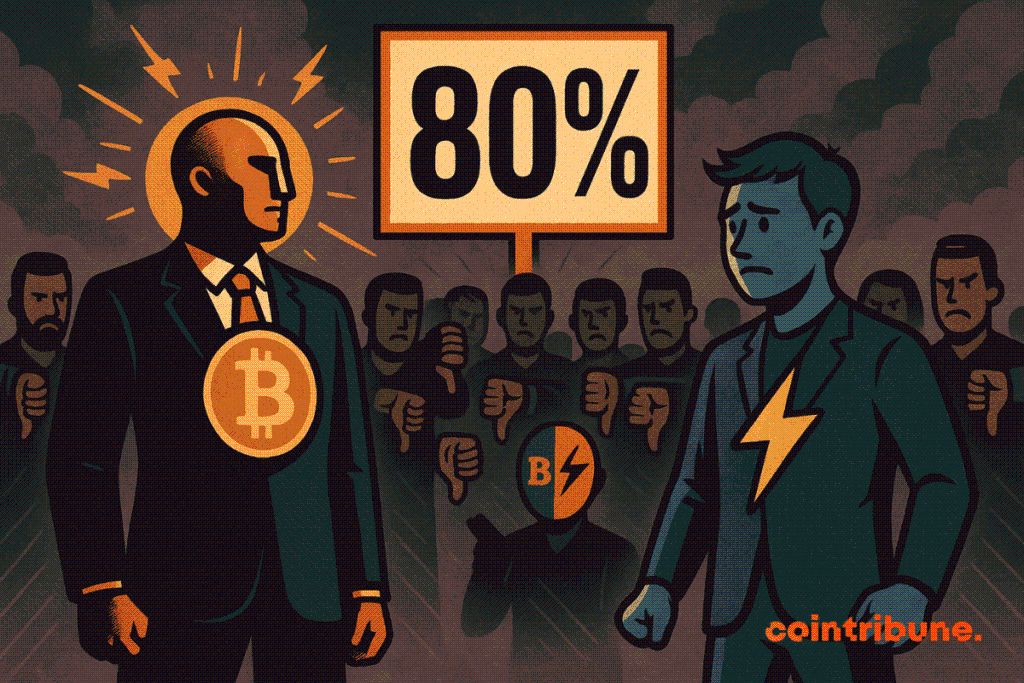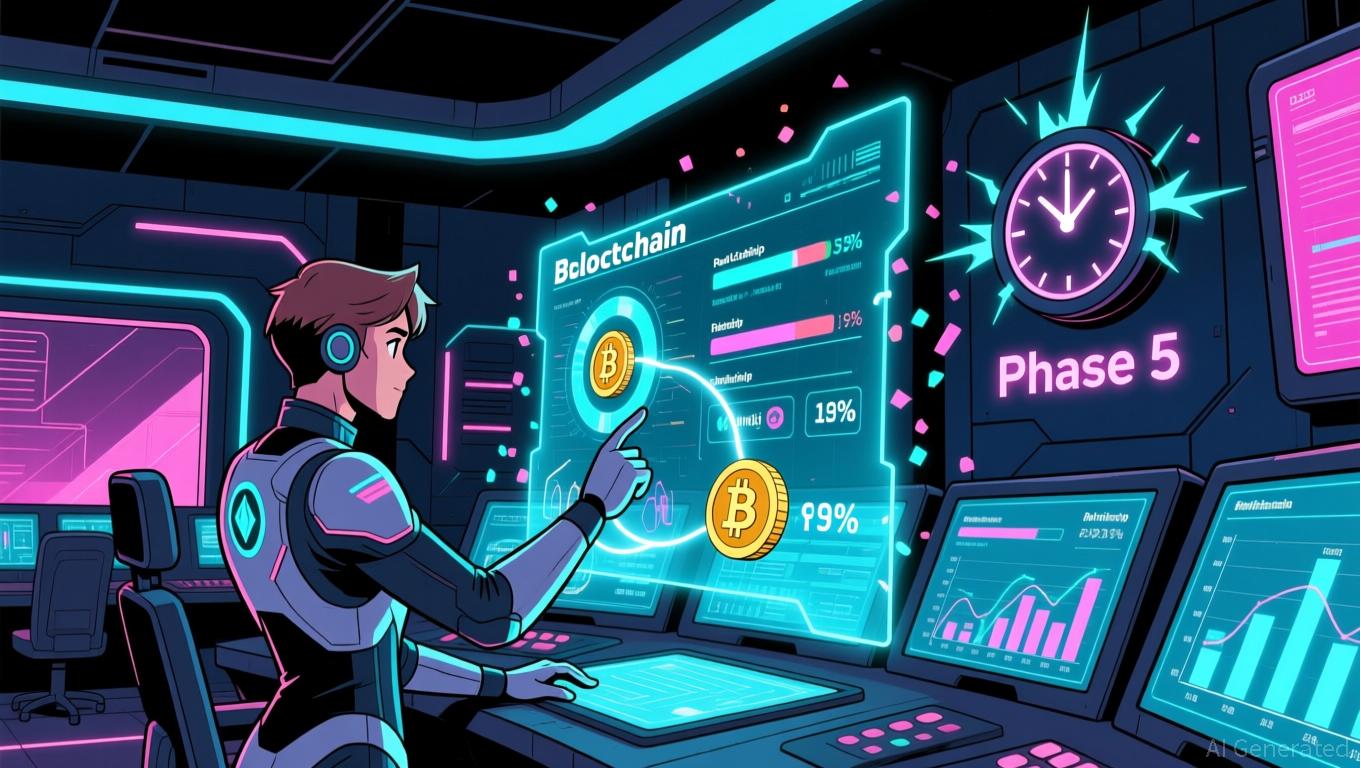Is the Lightning Network Losing Steam? The Numbers Raise Questions
An online survey sparked controversy: more than 80% of respondents believe that Lightning is not “real bitcoin.” A massive figure, and a clear divide between technical promise and market perception. The debate exploded on X, opposing pro-Lightning figures and sharp critics. Let’s summarize, decode, and project.

In brief
- A survey shows that 80% of respondents do not consider Lightning as real bitcoin
- The debate opposes critics mentioning complexity and liquidity dependence to defenders highlighting real use and micropayments
- Metrics stagnate while custodial products gain ground, hence the priority for a better UX and improvements like splicing.
Shocking survey, disrupted narrative
The message is harsh, for a large majority, Lightning does not embody “native” bitcoin. This perception is based on a simple intuition: if one must go on-chain to enter and exit the network, then Lightning appears as a separate environment, almost like a distinct token. The technical nuance, however, was not enough to convince.
In this context, the critics drove the point home. Paul Sztorc talks about a “cool system at first” that, over the years, “does not work.” He points out concrete constraints: nodes connected permanently, dependence on liquidity providers, need for watchtowers. For him, the user experience quickly slides toward custodial, and trust erodes.
On the other side, the response is clear. Alex Gladstein defends Lightning as a digital cash in bitcoin, without banks.
Matt Corallo adds a volume point: a double-digit share of BTC transactions would today be routed via Lightning. For them, the real-world reality already exists. The denial would, precisely, be to deny these uses.
The numbers that upset: stagnation and perceived centralization
Let’s look at the public metrics. The Lightning capacity is around a few thousand BTC , roughly the same level as in September 2022. No real surge in three years. The signal is clear: traction has not materialized at the hoped-for pace.
Another indicator, even tougher: the number of payment channels has almost halved since 2022, falling from over 80,000 to about 45,000. This is a marker of network density, surface, liquidity, and resilience. When channels diminish, the perception of centralization mechanically increases. And the “everyone can route everything” discourse loses credibility.
However, Lightning retains a key advantage: costs. Tiny payments, routed off-chain, sometimes approach a fraction of a cent. By contrast, on-chain bitcoin fees can devour hundreds of basis points on small amounts. On the “micropayments” axis, the technical advantage persists. But the narrative advantage, it wavers.
Competition from Bitcoin ETFs and revival avenues
Staying on the subject of perception, the context does not help. Volumes are exploding elsewhere, via ETFs. In Q3, JPMorgan observes a renewed interest in spot bitcoin ETFs , while wBTC-like and cbBTC progress. Apps like Moonshot, Base or Fomo boast onboarding in a few clicks, fast transactions, a smooth UX. The general public follows the slightest friction. And the bitcoin ecosystem pays for every step that seems too technical.
Should we bury Lightning? No. But we must tell the truth. The network has not converted the post-2022 trial. It remains powerful for specific cases: low-value recurring payments, “pay-per-use” models, targeted remittances. To scale, it lacks a “default” experience that hides the complexity of channels, liquidity, penalties, and connections. For market context, bitcoin trades today around the 106,000 $ mark at the time of writing, a symbolic milestone illustrating a moving ecosystem.
Disclaimer: The content of this article solely reflects the author's opinion and does not represent the platform in any capacity. This article is not intended to serve as a reference for making investment decisions.
You may also like
Ethereum News Update: Is Ethereum Really Headed for $60k? Kiyosaki's Confident Prediction or Just a Mistake?
- Robert Kiyosaki predicts Bitcoin could hit $250,000 and Ethereum $60,000 by 2026, challenging traditional finance norms. - His strategy emphasizes Bitcoin/gold as inflation hedges, citing Gresham's Law and Metcalfe's Law to justify decentralized asset accumulation. - Market reactions are mixed: critics dismiss his long-term crash warnings, while on-chain data and Arthur Hayes support potential rebounds. - Kiyosaki's bullish stance highlights growing crypto legitimacy as value stores, despite regulatory r

Bitcoin Updates: SoFi Integrates Banking with Cryptocurrency, Providing Safe Trading via an FDIC-Insured Application
- SoFi becomes first FDIC-insured U.S. bank to launch consumer crypto trading via its app, integrating banking and digital assets under regulatory oversight. - The service enables users to trade Bitcoin , Ethereum , and Solana directly from FDIC-protected accounts, emphasizing "bank-grade" security and eliminating external fund transfers. - A 60% user preference for bank-based crypto trading and 2025 regulatory clarity from OCC support the move, aligning with doubled U.S. crypto ownership and industry tren

SEC's Token Classification Ignites Regulatory Dispute With CFTC Over Cryptocurrency Oversight
- SEC proposes token taxonomy framework to classify crypto assets, excluding decentralized tokens and utilities from securities under the 1946 Howey Test. - Bipartisan bills aim to shift crypto commodity oversight to CFTC, raising concerns over agency capacity amid staffing shortages and pending leadership confirmations. - Regulatory overlap between SEC and CFTC intensifies as Congress seeks cohesive frameworks, balancing innovation incentives with investor protections in evolving crypto markets.

IPO Genie's Airdrop Connects Individual Investors with Elite Private Market Opportunities
- IPO Genie's $50,000 airdrop drives 320% sign-up surge, rewarding 40 participants with $IPO tokens for private-market access. - AI-powered blockchain platform offers utility-focused tokens with staking/governance rights, raising $12.5M from 40+ countries. - Merkle tree verification and linear vesting enhance credibility, though phishing risks and liquidity volatility remain concerns. - Phase 5 at 95% capacity creates urgency as stricter eligibility and higher prices loom in Phase 6, per Blockchain Reporte

